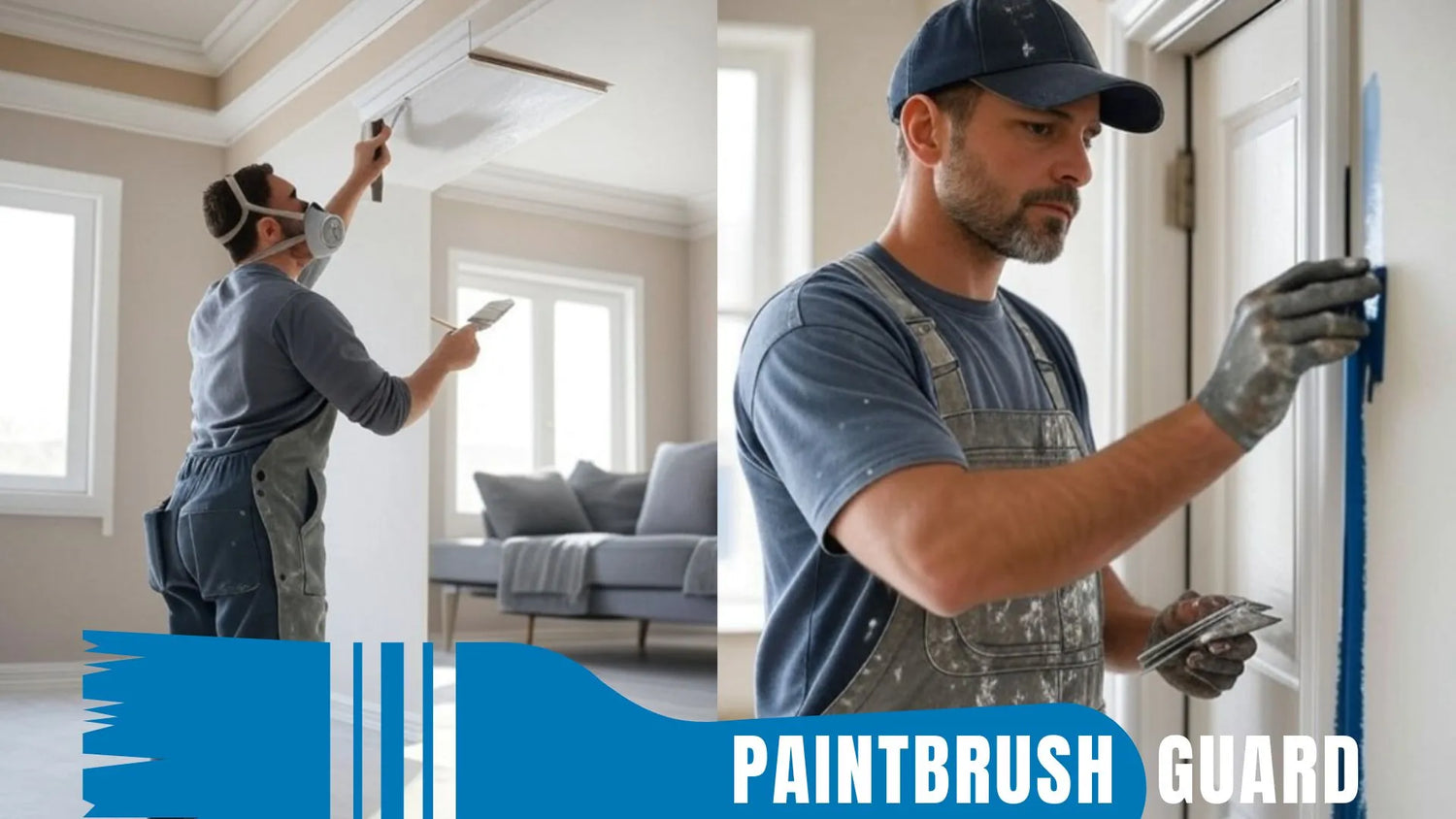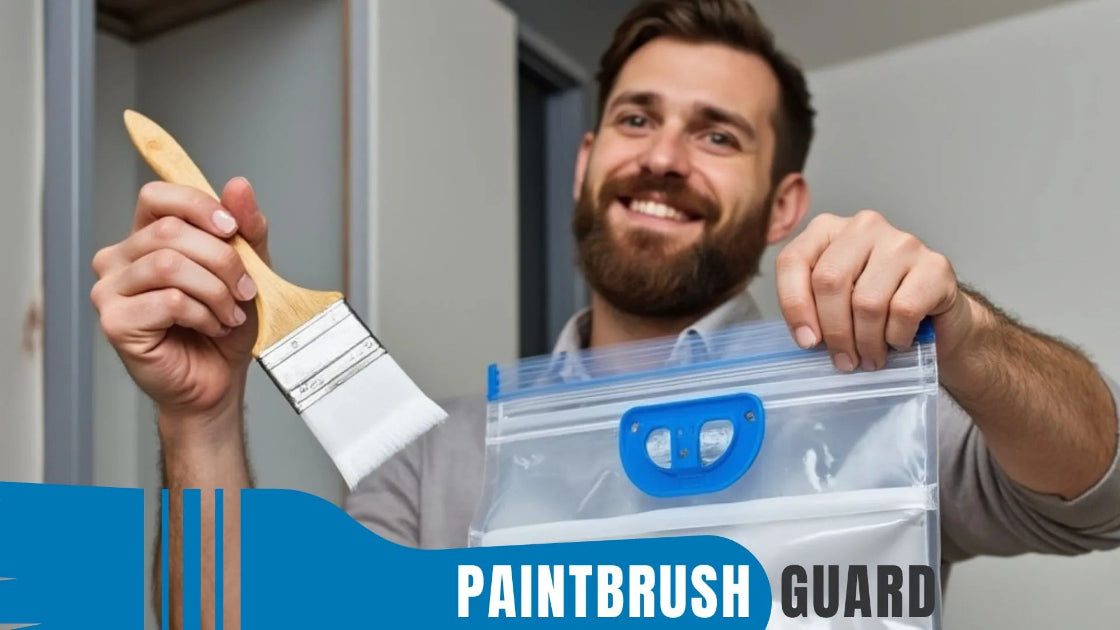
Home Paint Job Tips: Save Time and Paint Like a Pro
|
Time to read 15 min
|
Time to read 15 min
Painting your home can completely change the look and feel of your space, but it often seems like a daunting task that takes too much time and effort. What if you could simplify your home paint job with practical tips that save time, reduce mess, and deliver a professional finish?
With no cleanup required after a painting session, you can take a short break mid-project or wrap up your painting for the day, your brush stays ready without the need to clean.
A home paint job can be a rewarding project, but without the right strategies, it can quickly become overwhelming. You might end up with uneven walls, paint drips, or a brush that’s ruined after just one use.
These home paint job tips are designed to tackle those challenges, helping you save time, avoid mistakes, and achieve a polished finish. By using tools like Paintbrush Guard, you can also make your painting process more sustainable, reducing waste and saving money on supplies.
Preparation is essential for a successful home paint job, and these tips will set you up for success.
Before you begin your home paint job, take 30 minutes to plan. For a 12x12 room (4–6 hours of painting), decide which areas to tackle first—start with the ceiling, then walls, and finish with trim.
Make a list of supplies, including paint, brushes, tape, and drop cloths, to avoid mid-project trips to the store, which can add 1–2 hours to your timeline. Planning ahead keeps you organized, saving time and reducing stress.
Paintbrush Guard ensures your brush stays in perfect condition during your home paint job by preventing paint from drying on the bristles, allowing you to pause without worrying about cleanup.
Learn more about Paintbrush Guard: This guide tackles the top 20 questions about storing paintbrushes, from quick breaks to long-term care, and even challenges like humid coastal areas.
Prepping your space is a vital home paint job tip that prevents mistakes. For a 12x12 room, spend 1–2 hours moving furniture out or covering it with drop cloths, taping off edges with painter’s tape, and patching wall holes with spackle, sanding them smooth after drying (1 hour).
Clean walls with a damp cloth to remove dust, ensuring paint adheres well, taking 30 minutes. Proper prep avoids spills and uneven finishes, saving you from hours of touch-ups.
Paintbrush Guard helps you stay focused during prep by keeping your brush moist, so you can take breaks without the hassle of washing it each time, saving you up to 15–30 minutes per session.
Selecting the right paint and colors can make or break your home paint job. These tips simplify the process.
Choosing the right paint type is a crucial home paint job tip. For interior walls in a 12x12 room, use satin or eggshell finishes, they’re easy to clean and hide small flaws. For trim or bathrooms, opt for semi-gloss to resist moisture.
In 2025, eco-friendly low-VOC paints like Sherwin-Williams Harmony are popular, costing $40–$80 per gallon, and they reduce harmful fumes, making your home paint job safer and greener.
Paintbrush Guard simplifies the process of testing paint types by keeping your brush ready for action, allowing you to switch between samples without cleaning, which can save you valuable time.
Paintbrush Guard: This article explores how Paintbrush Guard’s paintbrush vacuum storage reduces toxic waste and supports sustainable house painting practices, making it an essential tool for environmentally conscious painters tackling house painting projects.
Testing colors is a smart home paint job tip to avoid costly repaints. For a 12x12 living room, buy sample cans (about $5–$10 each) of 2–3 colors, like a soft gray or warm beige, and paint small patches on different walls, taking 30 minutes.
Observe them under natural and artificial light over 24 hours to see how they look. This prevents choosing a color that looks off after drying, saving you from repainting an entire room, which can take 4–6 hours.
Paintbrush Guard allows you to test colors efficiently by keeping your brush in a usable state during breaks, ensuring the bristles remain soft and ready for the next sample.
These painting techniques will help you work faster and smarter during your home paint job.
Painting a room quickly is a top home paint job tip for tight schedules. For a 12x12 room (4–6 hours), use a 2–3-inch angled brush for cutting in and a roller for large areas.
Tape off edges (30–45 minutes), cut in along corners and trim, then roll in 3x3-foot sections, working top to bottom to catch drips. Keep a wet edge to avoid lap marks, cutting your painting time by 20%.
Paintbrush Guard enhances your efficiency by preserving your brush’s condition during pauses, so you can resume painting without delay, saving up to 15–30 minutes per break.
Cutting in corners neatly is a precision home paint job tip. Use a 1–2-inch angled sash brush for a 12x12 room, dipping the bottom third into the paint and tapping off excess.
Paint a straight line along one wall, then the other, forming a clean “V” shape in the corner, taking 30–45 minutes per coat. Blend strokes in small sections to avoid buildup, ensuring sharp, clean corners.
Paintbrush Guard ensures your brush stays soft and pliable during breaks, allowing you to maintain precision without the bristles hardening, which can save you time on rework.
Paintbrush Guard Benefits: Learn more about the benefits of Paintbrush Guard vacuum storage. Save time, reduce water waste, prevent chemical pollution and cut costs on supplies for house painting projects.
Painting trim without streaks is a must-know home paint job tip. Use a 1–2-inch angled sash brush for a 12x12 room (30–45 minutes per coat), taping off adjacent areas (30–45 minutes).
Load the brush lightly, dipping the bottom third into the paint, and tap off excess. Paint in long, steady strokes along the grain, feathering edges to blend, and use semi-gloss paint for a durable, streak-free finish.
Paintbrush Guard helps you achieve flawless trim by keeping your brush in optimal condition during pauses, ensuring the bristles remain flexible for precise application.
These tips focus on painting specific areas of your home with ease and precision.
Painting kitchen cabinets is a transformative home paint job tip. For a standard kitchen (2–3 hours), sand cabinets with 220-grit sandpaper, then use a 2-inch angled brush.
Load the brush lightly, dipping the bottom third into the paint, and tap off excess. Paint with the grain in long, smooth strokes, applying thin coats, and sand lightly between coats for a sleek finish, using semi-gloss paint for durability.
Paintbrush Guard allows you to take breaks without worrying about your brush drying out, ensuring consistent application across multiple coats for a smooth cabinet finish.
This article explores how Paintbrush Guard’s paintbrush vacuum storage saves money, promotes eco-friendly house painting practices and enhances efficiency.
Painting a small bathroom efficiently is a space-enhancing home paint job tip. For a 5x8 bathroom (2–3 hours), use a 2-inch angled brush for corners and a small roller for walls.
Tape off fixtures (30 minutes), and choose a moisture-resistant semi-gloss paint, applying in thin, even coats to avoid drips. Work top to bottom, ventilating the space to speed drying and prevent moisture buildup.
Paintbrush Guard supports efficient bathroom painting by keeping your brush ready for use, so you can pause without the bristles hardening, saving you time on cleaning.
Painting ceilings without drips is a pro-level home paint job tip. For a 12x12 room (4–6 hours), use a 3–4-inch flat brush for edges and a roller for larger areas.
Load the brush by dipping the bottom half into the paint, tapping off excess, and cut in along the ceiling edges with a 2–3-inch border, using long, smooth strokes. Roll in small sections, working systematically to avoid drips and lap marks.
Paintbrush Guard ensures your brush remains in top shape during ceiling painting, preventing paint from drying on the bristles and allowing you to resume work quickly.
Exterior painting requires special techniques, and these tips will help you get it right.
Painting your house exterior efficiently is a powerful home paint job tip. For a 1,500-square-foot house (20–40 hours), use a 3–4-inch flat brush for trim and a roller for siding.
Prep by power-washing (2–3 hours), taping off windows (1–2 hours), and applying a primer to bare spots (2–3 hours). Paint in 3x3-foot sections, working top to bottom in the shade to avoid lap marks, using acrylic latex paint for durability.
Paintbrush Guard enhances your exterior painting by keeping your brush moist during pauses, ensuring you can pick up right where you left off without cleaning, which saves time.
Find the 7 best green paint colors for your interior walls with our top picks. Learn about paint finnish, the natural vibe and rooms to apply for perfection.
Painting a fence is a curb-appeal-boosting home paint job tip. For a 50-foot fence (4–6 hours), use a 3–4-inch flat brush, dipping the bottom half into the paint and tapping off excess.
Apply in long, even strokes along the grain, working in 2–3-foot sections, using a stippling motion to fill crevices, then smooth with light strokes. Paint in the shade to avoid quick drying, working top to bottom to catch drips.
Paintbrush Guard keeps your brush in excellent condition throughout the process, ensuring the bristles stay soft and effective for even application on rough surfaces like fences.
Avoiding mistakes during your home paint job saves time and ensures a polished result.
Avoiding drips and spills is a critical home paint job tip. For a 12x12 room (4–6 hours), load your 2-inch angled brush lightly by dipping the bottom third into the paint, tapping off excess.
Paint in thin, even strokes, working in 1–2-foot sections, and hold the brush at a 45-degree angle. Work top to bottom to catch drips, and keep a damp cloth handy to wipe spills immediately, saving rework time.
Paintbrush Guard helps you avoid drips by ensuring your brush doesn’t harden during breaks, allowing for smoother, more controlled strokes when you resume painting.
This guide showcases the top 8 gray paint colors, available on Amazon, selected based on current popularity, including favorites like Agreeable Gray.
Fixing painting mistakes quickly is an essential home paint job tip. For a 12x12 room (4–6 hours), sand drips with 220-grit sandpaper and repaint with a 2-inch angled brush in thin coats, taking 20–30 minutes per spot.
Cover streaks by rolling over with a fresh coat, maintaining a wet edge. Wipe wet paint spills with a damp cloth immediately to avoid extra work, saving 1–2 hours of repainting.
Paintbrush Guard makes fixing mistakes easier by keeping your brush ready for touch-ups, ensuring the bristles are always soft and effective for precise corrections.
Painting over dark colors is a challenging home paint job tip made simple. For a 12x12 room (4–6 hours), apply a high-quality primer like Kilz to block the dark shade, taking 1–2 hours for one coat.
Use a 2–3-inch angled brush for cutting in and a roller for walls, applying two coats of primer if needed, then two topcoats of your new color, adding 2–3 hours per coat for drying.
Paintbrush Guard ensures your brush remains usable between primer and topcoat applications, preventing the bristles from drying out and saving you from cleaning interruptions.
These tips help you save money and work more efficiently during your home paint job.
Calculating paint needs accurately is a cost-saving home paint job tip. For a 1,500-square-foot house (20–40 hours), estimate 1 gallon per 400 square feet per coat, needing 4–5 gallons for walls ($30–$70 each), per 2025 painting guides.
Add 1–2 quarts for trim. Measure your space, accounting for two coats, and add 10% for touch-ups, taking 30 minutes to plan, saving you from overbuying.
Paintbrush Guard helps you use paint more efficiently by keeping your brush in top condition, reducing the chance of wasting paint due to dried bristles.
Discover 5 top neutral paint colors for modern living rooms : Warm Beige, Soft Gray, Light Taupe, Cool Greige, & Off-White with timeless, versatile shades.
Reducing costs is a practical home paint job tip. For a 1,500-square-foot house (20–40 hours), DIY painting cuts labor costs ($1,000–$3,500), saving up to 50%, per 2025 HomeAdvisor estimates.
Use leftover paint for touch-ups, saving $30–$70 per gallon, and buy in bulk for discounts. Prep properly to avoid repaints, which can add $200–$500 in extra paint and supplies.
Paintbrush Guard lowers costs by extending the life of your brush, preventing the need for frequent replacements and reducing paint waste during breaks.
These tips help you tackle unique surfaces during your home paint job.
Painting brick surfaces is a unique home paint job tip. For a small brick wall (4–6 hours), use a 3–4-inch flat brush, dipping the bottom half into the paint and tapping off excess.
Use a stippling motion to push paint into crevices, then smooth with light strokes, working in small sections top to bottom to avoid pooling, ensuring thorough coverage on the textured surface.
Paintbrush Guard ensures your brush stays effective on textured surfaces by preventing paint from drying out, allowing for consistent application across the brick.
Painting metal railings is a durability-focused home paint job tip. For a 10-foot railing (1–2 hours), sand with 220-grit sandpaper to remove rust, then apply a rust-inhibiting primer.
Use a 1–2-inch angled brush, dipping the bottom third into the paint, and tap off excess. Paint in short, controlled strokes, following the railing’s contours, applying thin coats to avoid drips.
Paintbrush Guard supports precise painting on metal by keeping your brush in perfect condition during breaks, ensuring smooth, controlled strokes for a flawless finish.
Discover how house paint colors influence mood & get expert tips on choosing the best colors for every room to create a vibrant, harmonious home environment.
These final tips ensure your home paint job ends with a professional touch.
Cleaning up efficiently is the final home paint job tip. For a 12x12 room (4–6 hours), clean brushes immediately with warm water and soap for latex paint or mineral spirits for oil-based paint, taking 10–15 minutes.
Remove tape while paint is wet to avoid peeling, and store leftover paint in airtight containers for touch-ups, saving $30–$70 per gallon. Dispose of waste responsibly to minimize environmental impact.
Paintbrush Guard simplifies cleanup by keeping your brush usable during the project, reducing the frequency of deep cleaning and saving water.
These home paint job tips make painting your home faster, easier, and more sustainable, helping you achieve professional results without the hassle.
From planning and color selection to painting techniques and cleanup, each tip saves time, reduces waste, and ensures a flawless finish.
Paintbrush Guard has become a must-have tool, supporting eco-friendly trends by minimizing water and paint waste. Whether you’re painting a 1,500-square-foot exterior or a small bathroom, these tips, paired with Paintbrush Guard, will transform your home while keeping your project green.
Paint smarter, save time, and enjoy a space that looks professionally done, all with these practical, sustainable tips.
Creating a detailed plan for a living room accent wall project, including a supply list and painting order (ceiling, walls, trim), prevents mid-project delays. This organizes the workflow, minimizes disruptions, and ensures a smooth process, saving time and achieving a professional finish.
Low-VOC paints, ideal for a nursery refresh, reduce harmful fumes, improving indoor air quality and safety. These sustainable options provide durable, vibrant finishes while minimizing environmental impact, making them a smart choice for health-conscious and eco-friendly home painting projects.
The Paintbrush Guard’s vacuum-seal technology keeps brushes wet for a kitchen cabinet repaint, saving 15 minutes per break by eliminating cleanup. This maintains bristle softness, reduces water and solvent use, and ensures seamless resumption, enhancing efficiency and eco-conscious painting.
For a garden shed exterior, use a 3–4-inch flat brush with light paint loads, applying thin, even strokes and wiping drips immediately. Working top to bottom in shaded areas prevents quick drying, ensuring a clean, professional look with minimal paint waste.
Using a 1–2-inch angled sash brush and taping off edges for a staircase trim project ensures precise, streak-free lines. Painting in long, controlled strokes and removing tape while wet prevents peeling, saving rework time and delivering a polished, professional finish.

Learn about eco-friendly painting, tips and tutorials on house interior and exterior surfaces, so you can get started with your project without any surprices during or after your painting.

Learn how interior house paint colors influence mood with expert tips on room preference so you can pick the best colors for a harmonious home environment.
We focus on the most popular shades for each interior colors, so you don't miss no matter what color you pick.

Learn how this innovative tool allows you to store paintbrushes without the need for immediate cleaning, offering significant advantages in time savings, water conservation, reduced chemical pollution, and lower costs for supplies.



